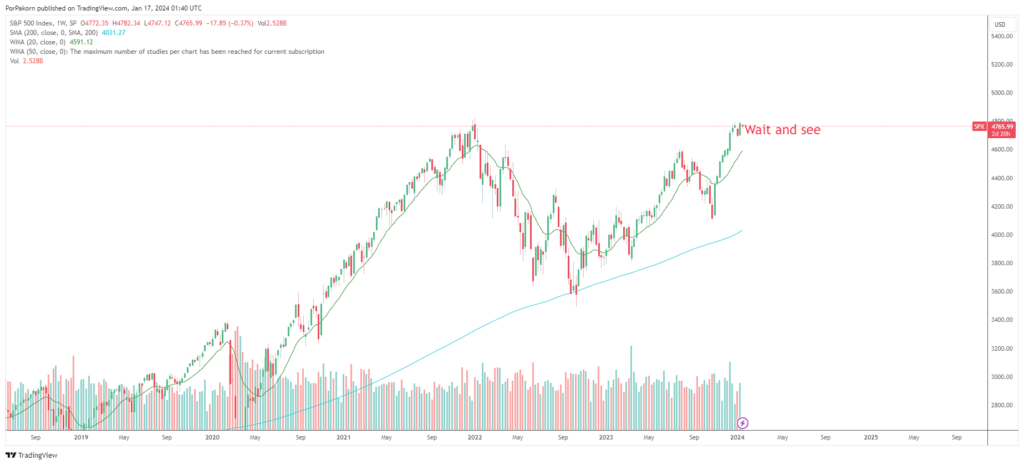Introduction
In December 2023, the Federal Reserve adhered to expectations by maintaining the fed funds rate at 5.25%-5.5%, marking the third consecutive meeting. Policymakers hinted at potential 75 basis points cuts in 2024, aligning with market expectations. Their assessment acknowledged a slowdown in economic growth and moderated job gains. Despite challenges, officials underscored the ongoing strength of job markets and the persistently low unemployment rate. While inflation experienced some relief over the past year, it remained elevated, prompting the central bank to release updated projections.
The updated projections painted a nuanced economic outlook. GDP growth is projected to exceed expectations in the current year, with a revised estimate of 2.6%, surpassing the earlier projection of 2.1% in September. However, the forecast for 2024 portrayed a slightly dimmer picture, with growth expected to dip to 1.4% compared to the previous estimate of 1.5%. A notable adjustment was made to the Personal Consumption Expenditures (PCE) inflation figures, showcasing a downward revision for both 2023 (2.8% from 3.3%) and 2024 (2.4% from 2.5%). Similarly, core PCE inflation is anticipated to ease to 3.2% in 2023 (down from 3.7%) and 2.4% in 2024 (down from 2.6%).
Unemployment projections remained stable, with expectations of a 3.8% rate for 2023 and a marginal increase to 4.1% in the following year. The release of the “dot plot” graph provided further insights, indicating a median year-end 2024 projection for the federal funds rate at 4.6%, a noteworthy decline from the 5.1% projection seen in September.
The looming prospect of “Fed Rate cuts” injects uncertainty into the financial landscape. Investors and businesses closely monitor the central bank’s every move, seeking cues on the potential impact of these anticipated cuts. While the Federal Reserve’s decisions are driven by a complex web of economic indicators, the prospect of rate cuts underscores the delicate balancing act between stimulating economic activity and addressing inflationary pressures.

Navigating these uncharted waters requires investors to maintain a vigilant stance, keeping a close eye on evolving economic indicators and central bank communications. The prospect of rate cuts introduces both opportunities and risks, making it imperative for market participants to adopt a diversified and resilient investment strategy. As the Federal Reserve adjusts its monetary policy levers, astute investors may find opportunities in sectors that stand to benefit from lower interest rates, such as housing and consumer-related industries. Simultaneously, a prudent risk management approach is crucial to mitigate potential downsides associated with economic uncertainties.
Conclusion
In conclusion, the Federal Reserve’s decision to maintain a steady course in December 2023, coupled with the indication of potential rate cuts in 2024, has added a layer of complexity to the economic landscape. As the central bank grapples with the delicate task of balancing growth and inflation, investors must remain adaptive and well-informed. The nuanced projections and adjustments in key economic indicators underscore the evolving nature of the financial markets. By staying attuned to these developments, investors can position themselves strategically to navigate the challenges and opportunities that lie ahead.






mexican rx online: mexican pharmacy online – п»їbest mexican online pharmacies
mexico drug stores pharmacies
http://cmqpharma.com/# mexican rx online
mexico pharmacies prescription drugs
indian pharmacy paypal: india pharmacy mail order – mail order pharmacy india
mexico drug stores pharmacies: mexico drug stores pharmacies – mexican mail order pharmacies
http://foruspharma.com/# mexico drug stores pharmacies
mexican rx online purple pharmacy mexico price list best online pharmacies in mexico
canadian pharmacy sarasota: canadian pharmacy review – canada pharmacy reviews
https://canadapharmast.com/# canadian discount pharmacy
mail order pharmacy india pharmacy website india reputable indian pharmacies
mexican online pharmacies prescription drugs: п»їbest mexican online pharmacies – medication from mexico pharmacy
mexico pharmacy purple pharmacy mexico price list mexican mail order pharmacies
http://indiapharmast.com/# best india pharmacy
india pharmacy: pharmacy website india – best online pharmacy india
mexico drug stores pharmacies: mexican mail order pharmacies – mexico drug stores pharmacies
canadian pharmacy ed medications online canadian pharmacy cheap canadian pharmacy online
canadian 24 hour pharmacy: canadian pharmacy meds reviews – canadian pharmacy price checker
https://foruspharma.com/# п»їbest mexican online pharmacies
mexican pharmacy: mexican pharmaceuticals online – pharmacies in mexico that ship to usa
canada pharmacy world: canada pharmacy 24h – canada drug pharmacy
mexico drug stores pharmacies best online pharmacies in mexico mexican drugstore online
mexican mail order pharmacies: medication from mexico pharmacy – buying from online mexican pharmacy
https://indiapharmast.com/# indian pharmacies safe
best canadian online pharmacy my canadian pharmacy review canadian pharmacy near me
mexican online pharmacies prescription drugs: pharmacies in mexico that ship to usa – pharmacies in mexico that ship to usa
http://doxycyclinedelivery.pro/# doxycycline prices australia
paxlovid for sale: paxlovid generic – paxlovid for sale
http://doxycyclinedelivery.pro/# how to buy doxycycline without a prescription
buy cipro online: buy cipro without rx – where to buy cipro online
where can i buy generic clomid without prescription: where can i buy clomid – can i buy generic clomid
https://clomiddelivery.pro/# where to buy cheap clomid without dr prescription
where to get cheap clomid price where to get clomid prices where can i buy clomid for sale
http://clomiddelivery.pro/# buying cheap clomid no prescription
cipro ciprofloxacin purchase cipro buy generic ciprofloxacin
https://doxycyclinedelivery.pro/# doxycycline pills cost
buy generic ciprofloxacin: cipro – buy cipro online canada
https://amoxildelivery.pro/# amoxicillin 500 mg
http://doxycyclinedelivery.pro/# doxycycline generic brand
http://clomiddelivery.pro/# where to buy cheap clomid
paxlovid pharmacy paxlovid covid Paxlovid buy online
where can i get doxycycline: order doxycycline online canada – doxycycline medicine
https://clomiddelivery.pro/# generic clomid pill
http://amoxildelivery.pro/# amoxicillin discount coupon
https://clomiddelivery.pro/# can i get clomid online
amoxicillin online purchase can you buy amoxicillin over the counter canada amoxicillin cephalexin
buying cheap clomid without insurance: order cheap clomid without prescription – how can i get clomid without insurance
http://amoxildelivery.pro/# generic amoxicillin over the counter
http://paxloviddelivery.pro/# paxlovid for sale
http://amoxildelivery.pro/# cost of amoxicillin
cost cheap clomid online cheap clomid no prescription where can i buy generic clomid pills
amoxicillin generic: generic amoxil 500 mg – amoxicillin online without prescription
https://ciprodelivery.pro/# buy ciprofloxacin over the counter
http://clomiddelivery.pro/# can i get clomid without prescription